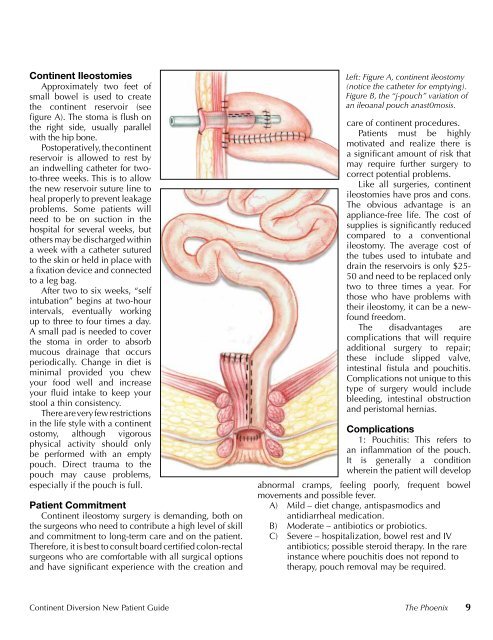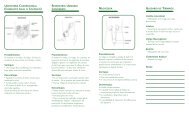Continent Diversion - United Ostomy Associations of America
Continent Diversion - United Ostomy Associations of America
Continent Diversion - United Ostomy Associations of America
You also want an ePaper? Increase the reach of your titles
YUMPU automatically turns print PDFs into web optimized ePapers that Google loves.
<strong>Continent</strong> Ileostomies<br />
Approximately two feet <strong>of</strong><br />
small bowel is used to create<br />
the continent reservoir (see<br />
fi gure A). The stoma is fl ush on<br />
the right side, usually parallel<br />
with the hip bone.<br />
Postoperatively, the continent<br />
reservoir is allowed to rest by<br />
an indwelling catheter for twoto-three<br />
weeks. This is to allow<br />
the new reservoir suture line to<br />
heal properly to prevent leakage<br />
problems. Some patients will<br />
need to be on suction in the<br />
hospital for several weeks, but<br />
others may be discharged within<br />
a week with a catheter sutured<br />
to the skin or held in place with<br />
a fi xation device and connected<br />
to a leg bag.<br />
After two to six weeks, “self<br />
intubation” begins at two-hour<br />
intervals, eventually working<br />
up to three to four times a day.<br />
A small pad is needed to cover<br />
the stoma in order to absorb<br />
mucous drainage that occurs<br />
periodically. Change in diet is<br />
minimal provided you chew<br />
your food well and increase<br />
your fl uid intake to keep your<br />
stool a thin consistency.<br />
There are very few restrictions<br />
in the life style with a continent<br />
ostomy, although vigorous<br />
physical activity should only<br />
be performed with an empty<br />
pouch. Direct trauma to the<br />
pouch may cause problems,<br />
especially if the pouch is full.<br />
Patient Commitment<br />
<strong>Continent</strong> ileostomy surgery is demanding, both on<br />
the surgeons who need to contribute a high level <strong>of</strong> skill<br />
and commitment to long-term care and on the patient.<br />
Therefore, it is best to consult board certifi ed colon-rectal<br />
surgeons who are comfortable with all surgical options<br />
and have signifi cant experience with the creation and<br />
Left: Figure A, continent ileostomy<br />
(notice the catheter for emptying).<br />
Figure B, the “j-pouch” variation <strong>of</strong><br />
an ileoanal pouch anast0mosis.<br />
care <strong>of</strong> continent procedures.<br />
Patients must be highly<br />
motivated and realize there is<br />
a signifi cant amount <strong>of</strong> risk that<br />
may require further surgery to<br />
correct potential problems.<br />
Like all surgeries, continent<br />
ileostomies have pros and cons.<br />
The obvious advantage is an<br />
appliance-free life. The cost <strong>of</strong><br />
supplies is signifi cantly reduced<br />
compared to a conventional<br />
ileostomy. The average cost <strong>of</strong><br />
the tubes used to intubate and<br />
drain the reservoirs is only $25-<br />
50 and need to be replaced only<br />
two to three times a year. For<br />
those who have problems with<br />
their ileostomy, it can be a newfound<br />
freedom.<br />
The disadvantages are<br />
complications that will require<br />
additional surgery to repair;<br />
these include slipped valve,<br />
intestinal fi stula and pouchitis.<br />
Complications not unique to this<br />
type <strong>of</strong> surgery would include<br />
bleeding, intestinal obstruction<br />
and peristomal hernias.<br />
Complications<br />
1: Pouchitis: This refers to<br />
an infl ammation <strong>of</strong> the pouch.<br />
It is generally a condition<br />
wherein the patient will develop<br />
abnormal cramps, feeling poorly, frequent bowel<br />
movements and possible fever.<br />
A) Mild – diet change, antispasmodics and<br />
antidiarrheal medication.<br />
B) Moderate – antibiotics or probiotics.<br />
C) Severe – hospitalization, bowel rest and IV<br />
antibiotics; possible steroid therapy. In the rare<br />
instance where pouchitis does not repond to<br />
therapy, pouch removal may be required.<br />
<strong>Continent</strong> <strong>Diversion</strong> New Patient Guide The Phoenix 9








